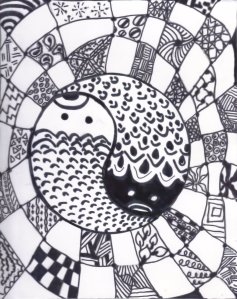Black and white, held to be polar opposites, both contain within themselves diametrically opposed meanings. White can be cold, sterile, barren, the color of funerals, grieving and death, Black can represent decay, despair, sin, funerals, grieving and death. White can be purity, spiritual ecstasy, new; death can be fecund, rich, warm, the source of the divine spark of life.
No wonder the Chinese married these opposites into a timeless symbol of wholeness – the immediately comprehensible Taijitu. The moment one sets eyes on this figure one knows what it means. Two opposing, yet complementary flowing black & white figures, each containing a piece of the other, fit together to form a complete circle. The inextricable oneness of yin (feminine) and yang (masculine) is obvious, especially to a Jungian who can easily perceive the anima and animus in the contrasting dots within each figure. The two halves of the circle resemble fish and people have been running with that association almost since it first appeared. When I considered the black and white prompt for a story about out-of-balance femininity and masculinity involved with a fish, the Taijitu figure was a no-brainer.
I decided to enclose my fisherman and his wife in an entangling net to represent how stuck they were in their marriage, their poverty, their assumptions, etc. The story of the Fisherman and His Wife disturbs and intrigues. It affects us. So, the net also represents the world net of Shiva, which one cannot touch without setting off vibrations that echo through the cosmos. Just as in the story, though it isn’t mentioned per se, all the changes effected by the wife and fish touch on hundreds of lives. AHA! I do believe I’ve just unraveled the meaning of those staggered, stepped maidservants, soldiers and flames, which so puzzled me.
I had great fun making Zen tangles out of the squares of the fish net. I used a Sharpie marker to draw them and the fish. The lines are rough and crude without the definition of a fine-tipped pen, because the story is kind of rough and crude itself.
The tangles represent the changing nature of the sea – its many moods and manifestations. They also stand for the shape-shifting nature of the fish who is also human. The Taijitu figure is derived from an intricate system of solar measurement used to determine the calendar. In my collage, along with the other meanings, it refers once again to the unchanging change nature of the natural world. The whole philosophy of Taoism rests on an idea inherent in this symbol – the complementary nature of opposing components. It is also the basis for the system of divination called the I Ching. So it is appropriate to use it to represent both the universal nature of storytelling and the divinatory way in which we use collage to reveal hidden meanings in our lives.
I’m very grateful to Leah Piken Kolidas of Creative Every day for sprinkling a bit of magic on this site with prompts that always send us in new directions.


Lovely!! I love the way you’ve been exploring black & white!
LikeLike
Thanks Leah- your site is such an inspiration- love the way you share your space.
LikeLike
Very zen! Lovely!
LikeLike
Thanks- I found your site lovely too – what a delightful place to live
LikeLike
Very creative zen tangle and wonderfully inspiring post ~ Enjoy ^_^
LikeLike